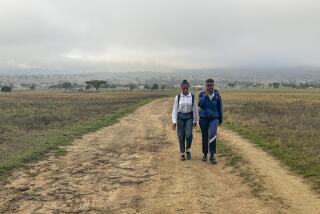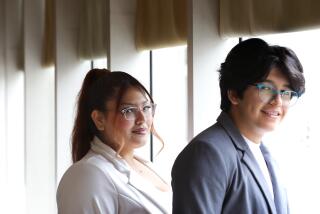The high cost of free education
- Share via
Nairobi, Kenya — THE story of Olympic Primary School reads like a movie script.
A spirited campus in Africa’s largest slum overcomes dire surroundings to triumph as the top-ranked public elementary school in Kenya’s capital, beating better-funded private academies and sending dozens of graduates to the nation’s top high schools.
Unfortunately, the saga doesn’t come with a Hollywood ending.
Perched on a hill overlooking Kenya’s notorious Kibera shantytown, the school is at the center of a growing public education crisis spurred by a national decision in 2003 to make primary education free to all. The move swelled Olympic’s classrooms to record size, stretched its budget and eroded the school’s hard-won standards.
Four years later, some of the brightest students are transferring to private competitors, causing the school’s ranking to slip. Rather than being visited by international dignitaries praising its accomplishments, the school and its bulging classrooms are a tourist stop for guides offering sightseers a glimpse of Kenya’s poverty and education woes.
Last month, Olympic’s enrollment was 2,510 students, making it one of the largest schools in the country. With just 30 teachers, the average class size is 84, more than double what it was when the school was ranked No. 1.
“That’s deadly,” said Anne Nganga, Olympic’s founder and former principal.
In 2004, having reached retirement age at 55 and fed up with the public school system, Nganga launched a private academy a few miles away. She worries that Olympic’s facilities and teaching staff are stretched too thin. “I’m afraid it is going to break,” she said.
Until 2003, Kenyan parents had to pay $150 a year to send their children to public primary school. That was less than what most private institutions charged, but even so the schools were out of reach for millions of children. Many families here live on just a few dollars a day.
Since the fees were eliminated, more than 1 million additional youngsters have entered public schools. The action has won international praise for President Mwai Kibaki, who is seeking reelection this year. His government said recently that it would attempt to extend free education into high school.
SO far, however, officials have failed to back their ambitious policy with adequate resources. Enrollment is up 24% since the fees were dropped, but the number of school facilities has barely expanded and the number of teachers has fallen 6%, according to the Education Ministry.
There are 10,000 fewer teachers than before the schools became free. With teacher salaries starting at slightly more than that of a maid -- about $210 a month -- some have quit in frustration and others have gone to private schools.
The government gives public schools $14.50 a year for each enrolled child, money that is supposed to cover everything from books and pencils to janitors and desks. At some schools, students must share textbooks. At a few, they sit on the floor or rocks because there isn’t enough furniture.
At Olympic, because of its reputation, 3,000 newcomers showed up to enroll in 2003 when free education debuted. At the time, 1,700 children were being taught there. Frustrated parents threatened to burn down the new principal’s office if she didn’t enroll their children.
Even now, a line of hopeful parents snaked outside her office door one recent morning. With enrollment already at record levels, Principal Ruth Namulundu must seek a balance between the school’s obligation as a government facility to admit students and her desire to maintain Olympic’s academic standards.
This day, she accepted one youngster and asked the other parents to try again next month.
“I don’t have the teachers,” Namulundu said. “Admissions is a big problem. We have to provide access. But my teachers don’t understand why I have to keep admitting students.”
School infrastructure and upkeep are constant struggles. There are no functioning computers. A urine stench from nearby toilets wafts into the first-grade classrooms.
Recess commences in a dirt field with a couple of grazing cows but no playground equipment. During the weekly schoolwide assembly and prayer, students squeeze shoulder to shoulder in a courtyard the size of a volleyball court.
Desperate for funding, school officials recently asked each student to contribute 1 cent so brooms and buckets could be purchased to keep the classrooms tidy.
For Emmanuel Onyango, 14, Olympic’s struggle to maintain excellence is anything but academic. His future is riding in large part on his school’s performance.
The fresh-faced eighth-grader has consistently ranked No. 1 or 2 in his class since the first grade. In a schoolwide competition last year, he won a $5 book voucher, which he used to buy a Danielle Steel romance novel.
Looking awkward in a parent-provided uniform that includes knee socks and short pants, the teenager sits attentively in the front row. He dreams of attending one of Kenya’s prestigious national high schools, the best in the country in quality and teaching. He wants to become a pilot.
“I think I can make it,” he said.
But with class sizes doubled, teachers are more distracted. Slower students get most of the attention. “Bigger classes have meant that teachers can’t concentrate on one person for very long,” Emmanuel said.
Instead of receiving advanced instruction, he usually finds himself tutoring the weaker students. His teacher, who uses Emmanuel to help teach math, said the tutoring reinforced the material.
“When advanced students know they will have to explain things to other students, they study harder and learn more,” said Ochieng Otiento, 44, who has taught at Olympic for 10 years.
Emmanuel said he enjoyed the tutoring but sometimes yearned for a more competitive environment. “I’d like someone who could challenge me,” he said.
School crowding is a problem across Africa, where education reform remains one of the toughest challenges. Factors including poverty and a surge in the number of AIDS-related orphans have left sub-Saharan Africa with the world’s lowest gross enrollment rates.
Despite recent improvement, an estimated 40 million school-age children in Africa are out of the classroom, condemned to lives as unskilled laborers and perpetuating the cycle of poverty for another generation.
In Kenya, the plight and performance of public schools have reached the point where some middle-income and even poor families are pulling out their children. Last year, public school enrollment in half of Kenya’s eight provinces dropped as parents who could afford private schools, where fees begin at about $260 a year, abandoned the public system.
Short-order cook Wambui Ndungu, 28, pulled her daughter from the local public school after the girl’s grades and test scores plummeted. The daughter is thriving in private school, but Ndungu and her husband, who earn about $140 a month, are paying nearly a quarter of the family income in school fees. That means longer hours at the cafe for Ndungu and less meat on the family dinner table.
“I know public school is free, but it just wasn’t worth it anymore,” Ndungu said.
Government officials say they are working as fast as they can to provide relief.
“I try to tell them: ‘Please continue your work. We are coming,’ ” said Margaret Thiongo, director of Nairobi’s public primary schools.
At Olympic, Thiongo noted that the government added several new classrooms over the last three years but was running out of land for expansion. She blamed understaffing on a shortage of qualified teachers.
WITH national graduation exams looming at the end of the year, Emmanuel is feeling pressure. Five years ago, Olympic sent nearly three dozen graduates to public national high schools. Last year, it sent five.
“I must score well,” he said. “This is the year that will determine my future.”
That’s not just teenage drama speaking. Eighth grade is a key year in Kenya’s educational system, marking the end of the line for many. Due to a severe shortage of public and private high schools, only about half of graduating primary school students find places.
Last year, 50 of 204 Olympic graduates were unable to go to high school because there weren’t enough seats.
With the decline in quality and test scores at public schools, graduates of the private academies, which account for only 10% of all schools, now make up 90% of the students at the best high schools.
With the odds stacked against him, Emmanuel is wasting no time, enrolling in after-school and weekend classes. That means staying at school from 7 a.m. to 5 p.m. during the week, eight hours on Saturday and another five hours on Sunday, not including the one to two hours of homework each night.
Sunday afternoon offers his only free time. “I sleep,” he said.
Even if he performs well, there’s no guarantee his mother will be able to afford the $450 in annual fees. With four children in school, his mother, a nurse, is saving for Emmanuel, but an older sister who was accepted to a top national campus had to settle for one that ranks lower and is less expensive.
“I’m praying God will help us,” Perazia Pilli Ogingo said.
Olympic officials also are doing what they can to keep standards high. Although its No. 3 ranking last year is impressive for a school of Olympic’s size, administrators who recall past performance remain fiercely competitive.
“Next year we will be No. 1 again,” said Monica Omwoyo, Olympic’s deputy principal.
To lower class size in the all-important eighth grade, the school shifted a teacher from another grade. The average eighth-grade class size dropped to 65. It also added after-school and weekend classes and recently issued a plea to eighth-grade parents for a one-time $5 donation to administer monthly practice exams, a luxury not afforded in the government budget.
But one parent complained to government regulators that Olympic was improperly charging for items that are supposed to be free, such as $4 a month for weekend classes and even the penny for a broom.
Government officials said Olympic might be crossing the line. “There should never be a policy by which students who don’t pay don’t learn,” said Thiongo, the city education director. She said weekend classes could be shut down.
But Emmanuel said he needs the extra study to stay sharp. He and his fellow students recently took a practice graduation exam for the first time. He was aiming for a score of 415. He got 412.
More to Read
Sign up for Essential California
The most important California stories and recommendations in your inbox every morning.
You may occasionally receive promotional content from the Los Angeles Times.










